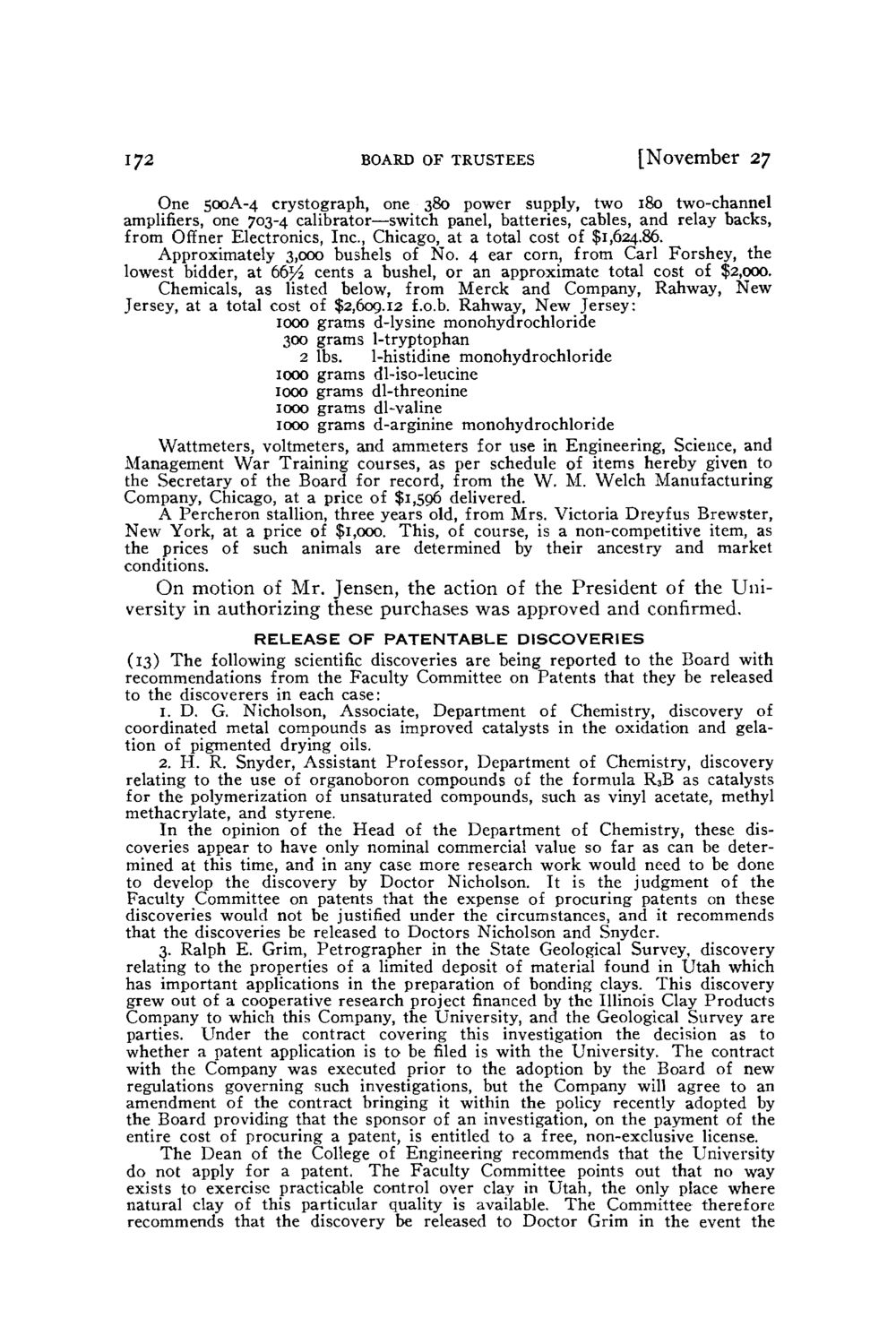| |
| |
Caption: Board of Trustees Minutes - 1944
This is a reduced-resolution page image for fast online browsing.

EXTRACTED TEXT FROM PAGE:
172 BOARD OF TRUSTEES [November 27 One 500A-4 crystograph, one 380 power supply, two 180 two-channel amplifiers, one 703-4 calibrator—switch panel, batteries, cables, and relay backs, from Offner Electronics, Inc., Chicago, at a total cost of $1,624.86. Approximately 3,000 bushels of No. 4 ear corn, from Carl Forshey, the lowest bidder, at 66% cents a bushel, or an approximate total cost of $2,000. Chemicals, as listed below, from Merck and Company, Rahway, New Jersey, at a total cost of $2,609.12 f.o.b. Rahway, New Jersey: 1000 grams d-lysine monohydrochloride 300 grams 1-tryptophan 2 lbs. 1-histidine monohydrochloride 1000 grams dl-iso-leucine 1000 grams dl-threonine 1000 grams dl-valine 1000 grams d-arginine monohydrochloride Wattmeters, voltmeters, and ammeters for use in Engineering, Science, and Alanagement W a r Training courses, as per schedule of items hereby given to the Secretary of the Board for record, from the W. M. Welch Manufacturing Company, Chicago, at a price of $1,596 delivered. A Percheron stallion, three years old, from Mrs. Victoria Dreyfus Brewster, New York, at a price of $1,000. This, of course, is a non-competitive item, as the prices of such animals are determined by their ancestry and market conditions. O n m o t i o n of M r . J e n s e n , t h e a c t i o n of t h e P r e s i d e n t of t h e U n i versity in a u t h o r i z i n g these p u r c h a s e s w a s a p p r o v e d a n d confirmed. RELEASE OF PATENTABLE DISCOVERIES (13) T h e following scientific discoveries are being reported to the Board with recommendations from the Faculty Committee on Patents that they be released to the discoverers in each case: 1. D. G. Nicholson, Associate, Department of Chemistry, discovery of coordinated metal compounds as improved catalysts in the oxidation and gelation of pigmented drying oils. 2. H . R. Snyder, Assistant Professor, Department of Chemistry, discovery relating to the use of organoboron compounds of the formula R3B as catalysts for the polymerization of unsaturated compounds, such as vinyl acetate, methyl methacrylate, and styrene. In the opinion of the Head of the Department of Chemistry, these discoveries appear to have only nominal commercial value so far as can be determined at this time, and in any case more research work would need to be done to develop the discovery by Doctor Nicholson. It is the judgment of the Faculty Committee on patents that the expense of procuring patents on these discoveries would not be justified under the circumstances, and it recommends that the discoveries be released to Doctors Nicholson and Snyder. 3. Ralph E. Grim, Petrographer in the State Geological Survey, discovery relating to the properties of a limited deposit of material found in Utah which has important applications in the preparation of bonding clays. This discovery grew out of a cooperative research project financed by the Illinois Clay Products Company to which this Company, the University, and the Geological Survey are parties. Under the contract covering this investigation the decision as to whether a patent application is to be filed is with the University. T h e contract with the Company was executed prior to the adoption by the Board of new regulations governing such investigations, but the Company will agree to an amendment of the contract bringing it within the policy recently adopted by the Board providing that the sponsor of an investigation, on the payment of the entire cost of procuring a patent, is entitled to a free, non-exclusive license. T h e Dean of the College of Engineering recommends that the University do not apply for a patent. T h e Faculty Committee points out that no way exists to exercise practicable control over clay in Utah, the only place where natural clay of this particular quality is available. T h e Committee therefore recommends that the discovery be released to Doctor Grim in the event the
| |